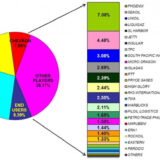Philippines’ import bill posts double-digit growth
The Philippines’ import bill posted double-digit growth in March. Data from the Philippine Statistics Authority (PSA) showed that the country imported USD 6.36 billion worth of goods in March, up 11.7% from USD 5.69 billion during the same period a year go. With the March increase, and despite the decline in February, first-quarter imports amounted to USD 18.597 billion, up 8.8% compared with last year’s USD 17.089 billion.
The National Economic and Development Authority (NEDA), the country’s planning agency, noted the continued demand for capital and consumer goods. Capital goods imports continued to grow in double digits for the seventh consecutive month, reaching USD 2.1 billion in March, while consumer goods imports rose to USD 1.2 billion due to higher spending for durable goods (67.9%) and non-durable goods (15.6%).
“The continued strength of merchandise imports and the fact that it is fueled by spending on capital goods bodes well for the economy,” said NEDA Director-General Emmanuel F. Esguerra.
“This growth also mirrors the positive prospects of the economy that are expected to be sustained for the rest of the year,” Esguerra said.
He said the government’s investments in public works contributed to growth in imports.
“Given the general sluggishness of import activities in the region, government support for higher spending on infrastructure is critical not only because it supports domestic demand but, more importantly, because it increases the country’s attractiveness to investors,” he said.
The Chamber of Automotive Manufacturers of the Philippines, Inc. (CAMPI) also reported record car sales during the period.
“We did see CAMPI reporting record car sales which was reflected in the consumer durable goods sub-sector, which zoomed to post a 67.9% growth, with passenger car sales up a whopping 93.7%,” said Nicholas Antonio T. Mapa, associate economist at one of the largest local banks, the Bank of the Philippine Islands (BPI).
Mapa said the growth in capital goods imports indicates positive long-term prospects for the economy, as businesses prepare for better times ahead.
“Torrid consumption has fuelled the impetus for expansion [with] all sub components of capital goods posting double digit growth,” he said.
In contrast, purchases of raw materials and intermediate goods, as well as mineral fuels and lubricants declined due to waning demand for wheat and crude materials and lower import payments for fossil-based fuels and lubricants, which are seeing historic low prices.











